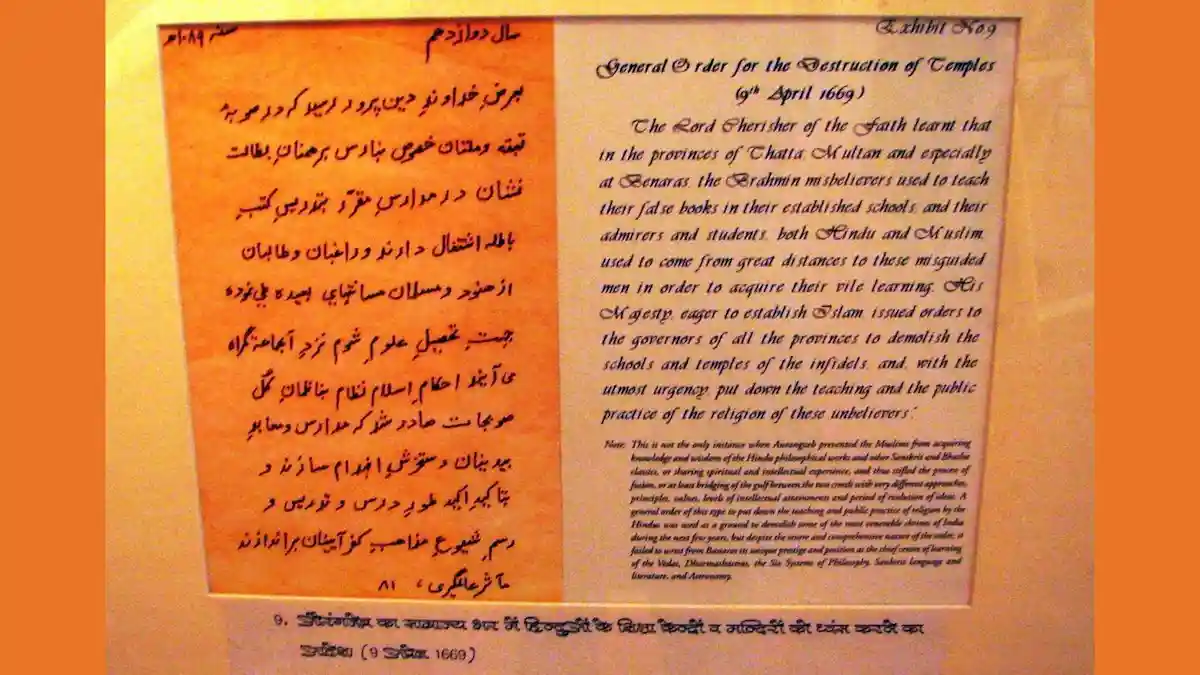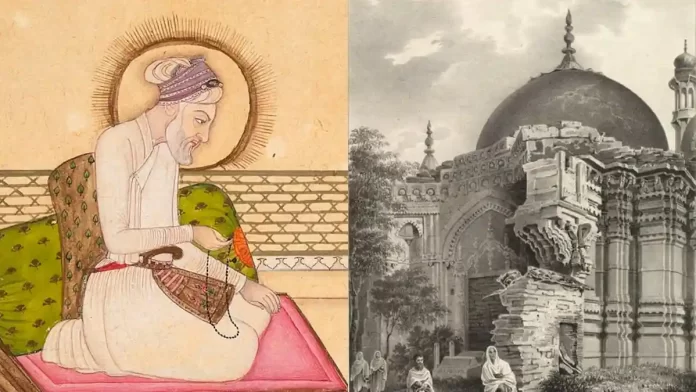Muslim groups on Saturday protested against the alleged videography of the Gyanvapi Mosque complex located beside the Kashi Vishwanath Temple in Varanasi.
For the unversed, a local court of Varanasi had ordered a survey of the Gyanvapi mosque in response to Hindu-Brahmins petitions alleging that the mosque was illegally built on a Brahmanical temple site.
Petitioners had argued inter-alia that the Mughal Emperor Aurangzeb had built the Gyanvapi Mosque after demolishing the Kashi Vishwanath Temple in the late 17th century.
While there were definitely religious angles behind temple demolitions, some socio-political and administrative reasons cannot be ruled out.
According to one Mughal firman attached below, Aurangzeb ordered the demolition of the Kashi Vishwanath Temple “to protect the unsophisticated Indians from falling into the fraudulent religious trap of clever Brahmins” (Audrey Truschke).
Historian Saqi Mustaid Khan
According to historian Saqi Mustaid Khan who wrote after Aurangzeb’s death, in 1669 “the Emperor learned that in Thatta, Multan, and especially at Benares, deviant Brahmins were teaching false books at their established schools”.
He writes further that “curious seekers Hindus and Muslims alike traveled great distances to gain depraved knowledge from Brahmins. Similar issues may have been present in the case of Mathura’s Keshava Deva Temple, which attracted Muslims as early as Jahangir’s reign”.
“All this prompted the Mughal Emperors to put to task such Brahmanical frauds and religious corruptions.” writes Saqi.

Audrey Truschke’s Opinion
According to Audrey Truschke, “generations of Mughal Emperors had attempted to curb certain religious behaviors, especially those of errant Brahmins who, in Mughal eyes, took advantage of the less sophisticated”.
“For example, Akbar took Brahmins to task for misrepresenting Hindu texts to lower castes and hoped that translating Sanskrit texts into Persian would prompt these (in his opinion), arrogant Brahmanical leaders, to reform their ways.”
“Aurangzeb similarly evinced concern with clever Brahmins deceiving common Hindus about religion and was perhaps especially alarmed that even Muslims were falling prey to clever Brahmin charlatans” points another Historian.
French traveler Jean de Thevenot
French traveler Jean de Thevenot opined that “Brahmins were numerous in Benares and found their Profit in lavish festivals that drew large crowds”.
However according to Audrey Truschke, the emperor didn’t order demolition of temples forthwith.
She says “that for most temples in Benares and elsewhere, Aurangzeb first ordered Mughal officials to investigate the dubious Brahmancial practices meant to lure commoners into their religious traps.”
“But in the case of certain institutions, including the Kashi Vishwanath temple of Varanasi and Keshava Deva Temple of Mathura, he deemed their demolition appropriate.” she writes in her acclaimed book – Aurangzeb the Man and the Myth.
From above, statements it is clear that Brahmanical temples were demolished to curb Brahmanical superstitions. This is further corroborated by writings of Father Joseph Tieffenthaler visited India between 1766-1771 AD.
He wrote historical and geographical description of India in latin. In the description of the Province of Oudh, following is stated:- “But a place especially famous is the one called Sitha Rassoi i.e. the table of Sita, wife of Ram, adjoining to the city in the South, and is situated on a mud hill. Subsequently, Aurangzeb or Babur, according to others, got this place razed in order to deny the noble people (Hindu Upper-Castes) the opportunity of practicing their superstitions. However, there still exists some superstitious cult in some place or other. For example, in the place where the native house of Ram existed, they go around 3 times and prostrate on the floor.
As to why Mosques were erected on the place of demolished temples, there could be several reasons like-
- To make the demolitions permanent
- To prevent rebuilding of Temples on such spots
- To fill the religious void that arose because of such demolitions
- To encourage locals to convert to Islam
- To demean Brahmanical classes
- To appease Muslim orthodoxy
What does Holy Quran Say?
Holy Quran says that “there are some who spend their time in idle diversions only to lead people astray from truth and deceived by the life of this world, they treat religion as a jest and sport. But all their efforts are wasted as they will be disgraced in this life as well as in the hereafter” [6:70]. Further,
“Say [O Muhammad] “Shall we tell you of those who lose most in respect of their deeds? They are those whose effort is lost in worldly life, while they think that they are doing well in their works. They are those who deny the Signs of their Lord and the fact of their having to meet Him in the Hereafter. Vain will be their works, nor shall We, on the Day of Judgment, give them any weight” That is their reward – Hell – for what they rejected Faith and took My signs and My messengers in ridicule” (Holy Quran 18:103-106)
“As for those who deny the truth and debar others from God’s path and from the Sacred Mosque which We set up for all people, natives, and strangers alike, and all who seek to profane it by evil-doing We shall make them taste a painful punishment” (Holy Quran 22:25)
Subaltern Opinions on Restorations
Subaltern studies point out that there is no point in asking for restoration of demolished temples in the name of all Hindus as most of the Hindu-Brahmanical temples were anyway built and meant for only a few upper-caste Hindus and that their doors were not open for Bahujan Indians (lower and backward castes who make over 80% of all Indians).
They opine that due to socio-political and electoral considerations, the Indian Government might have been forced to open Brahmanical temples to all classes of Hindus, incidents of discriminations against lower castes are still reported far and wide.
Secondly, as noted historian RS Sharma also point out, most of the so called grandest Brahmanical temples were generally built by the forced and unpaid labor of lower castes (eg Vishti System, Gupta Empire) and for centuries these big temples remained a nerve center of the caste system, superstitions, exploitation, and grave social injustices in India.
As opposed to this, many argue that in the history of Mosques, even slaves could stand side-by-side the rulers on equal footing as they all bowed together before one God as is evidenced by the oft-quoted example of the infamous Sultan Mahmud Ghazni and his slave Ayaz. (Iqbal)
Ek hi saf mein khade ho gae Mahmud wa Ayaz, na koi banda raha na koi banda nawaz
Banda-o-Sahib-o-Mohtaj-o-Ghani ek huye, teri sarkar mein pahunche toh sabhi ek huye.
Translation
When Sultan Mahmud Ghazni and his slave Ayaz stood side by side in the Mosque, it was as though no difference remained between the Emperor and the Slave.
Both the Rich and the Poor became one after entering your sublime dominion
Allama Iqbal
Nevertheless, communal issues must be sorted in good faith with dialogue and negotiations keeping in mind the broad constitutional goals of justice, equality, unity and fraternity amongst all classes of Indians in Amrit Kaal.
